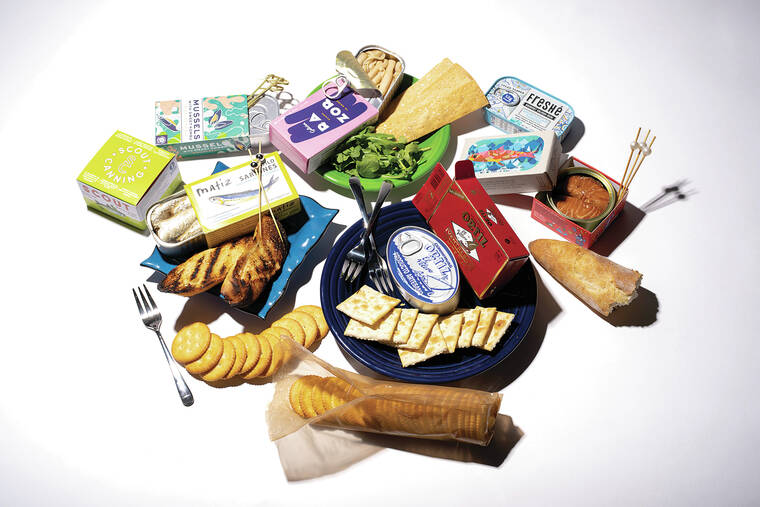Tinned fish is the hot new appetizer
MINNEAPOLIS — Put down the lutefisk.
It’s time to take a fresh look at preserved fish, and Minnesota’s favorite lye-soaked cod in white sauce is not on this hot new menu. Instead, just a thin sheet of metal stands between you and some of the world’s best seafood.
ADVERTISING
Several Twin Cities stores are increasing their supplies to meet the tinned-fish demand as charcuterie boards now star tins of mussels in escabeche sauce, and picnic baskets are stocked with delicate white tuna belly from Spain. At least one gourmet shop will open the can of your choosing and give you some crusty bread to go with it.
It’s a trend that’s only recently begun to catch on here, after a handful of restaurants on both coasts have devoted whole sections of their menus to tins, and more canneries are entering the market with catchy packaging and creative mix-ins.
“We’re seeing newer, cooler stuff come out and consumer response has been great,” said Keane Amdahl, marketing director of Coastal Seafoods. “We sell through a ton of canned seafood.”
With an affinity for pickled herring, Minnesotans are no strangers to foods that have been canned, jarred or preserved in other ways. At its essence, canning fish has always been about making fresh food last; feeding people economically, accessibly and healthfully; and letting nothing go to waste.
Tinned fish’s exciting new wave is just as utilitarian, stemming from the same traditional preservation practices but with an added element of luxury. Its origins trace to southern Europe, particularly Spain and Portugal, where conservas are a matter of national pride, and you can’t pass through a duty-free shop without being tempted to fill your carry-on with cans of it. One Lisbon chain, with a name that translates to the Fantastic World of Portuguese Sardines, looks like a candy store met a circus, only instead of sweets, the bold, striped cans contain oil and fish.
When chef J.D. Fratzke signed on to helm the food program for Wineside, a new wine bar and gourmet grocery shop in Minnetonka, one of the things he said he was most excited about was a whole display stacked with tins from across Europe and North America. The cans can be purchased to go or eaten in the restaurant, where they’re served with a side of aioli and Patisserie 46 bread.
“Whenever anybody thinks of canned tuna, they think of StarKist,” Fratzke said. “But we have this Ortiz stuff, bonito tuna from Sicily, and we have these stuffed calamari tubes, they’re simmered in a vinaigrette, so they’re super-hearty and delicious. I could take five cans of this up to the Boundary Waters for a weekend.”
Tins also can be a low-stakes way of trying something new, especially as popularity widens and more varieties of seafood make their way to the Midwest in canned form.
“We’re giving people an opportunity to taste a lot of things that they might not have had before,” Fratzke said.
Chef Jamie Malone started incorporating tinned fish into her menus during the height of the pandemic, when she operated a takeout-only pop-up from a downtown Minneapolis restaurant.
“It was like, omigod, what can we serve that has no contact and that would be super-fun? I couldn’t have people eat inside. So, I was like, what’s the coolest picnic food I can dream up? Ham and tinned fish,” Malone said. “Just the idea that you can just open up some cans and have some crackers, you’re not going to eat better food than that.”
But the road to making tinned fish a gourmet picnic treat was a long one for Malone. First she had to shake childhood memories of her dad opening a can of sardines with a key. “There wasn’t good stuff available,” she said. “I thought it was gross.”
When the world-famous Spanish chef and humanitarian José Andrés started his own line of tinned fish, Malone took notice.
“He’s been really passionate about saying, ‘Hey, this is a really, really good way to eat.’ It’s good for the world. It’s sustainable. It’s accessible to people in all sorts of communities,” she said. “If I had to trace it, I’d say him starting that started the sea change. Maybe this isn’t the weird [stuff] my dad kept in the cabinet to like, gross out his daughters. Maybe this is something really delicious and it can be on trend.”
It’s a trend that’s only growing in popularity.
Malone sells her favorite tuna in a curated chef’s pantry box through her Paris Dining Club, and she’s hoping to host tinned fish pop-ups in her North Loop studio.
But anyone can have a preserved fish party at home thanks to the variety and versatility of canned seafood.
“Good food can also be pretty easy,” Malone said. “You just open a can and put out some crackers and a little nice sea salt and there you go.”


